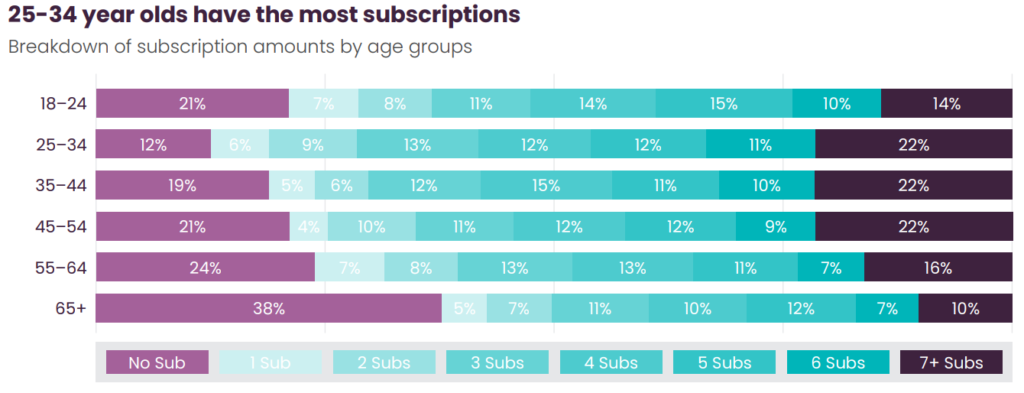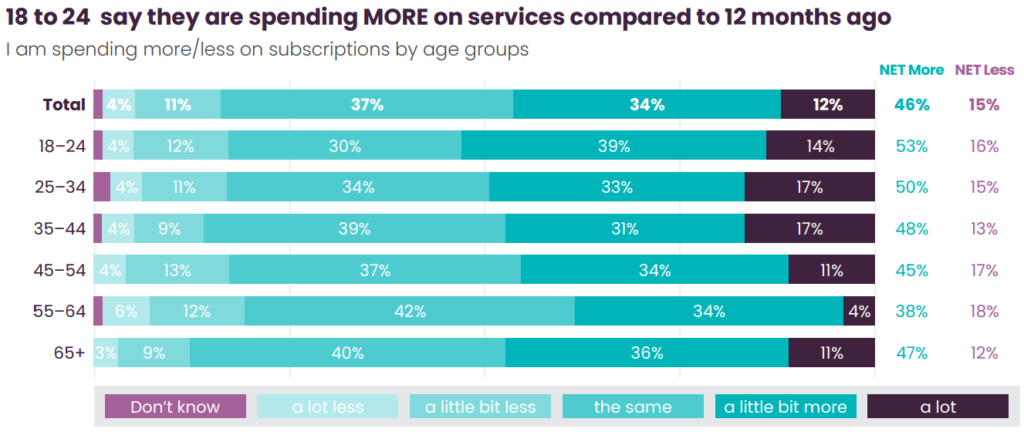|
Getting your Trinity Audio player ready...
|
New report presents key macro trends and predictions about the subscription economy. It underlines that retention is a top priority and shares the most effective strategies being used by subscription businesses across multiple industries.
“We have entered a third distinct phase for the subscription economy,” writes George Adelman, Principal, FT Strategies in a new report. The first phase beginning in the early 2000s saw digital subscriptions gradually take hold across various industries. It lasted for around 20 years and was followed by a second phase of acquisition growth during the COVID pandemic, “which helped spike the already healthy consumer appetite for subscriptions.” The third phase is the retention phase.
Depending on which sources you use, it is estimated that due to COVID-19 as a global society we’ve jumped ahead between 5 and 10 years in our digital adoption and consumption behaviors.
Matt Williamson, Banking and Fintech Futurist and Industry Advisor
The report, Subscription Economy: A Transformed World by Minna Technologies in partnership with FT Strategies, seeks to illuminate key macro trends and predictions and provide actionable insights for businesses to support, empower and retain their subscribers. It’s based on surveys of more than 1,000 consumers each in the UK and the US, 50 subscription business executives, and over 20 thought leaders from media and other industries.
93% report increased awareness of their subscription spend
“The retention phase will likely be one in which consumers will be more reserved about their spending and will be more likely to jump from one subscription to another to find the best fit for their needs,” notes Adelman. 68% of the 50 leading subscription businesses surveyed say that retention is their ‘top strategic priority.’ It serves to protect their revenues, as well as increase customer loyalty.
Businesses will therefore need to think even more actively and strategically about how to retain acquired subscribers (especially those from COVID) with customer-centric payment and pricing strategies, more transparent and intuitive UX experiences, and increased personalization of product offerings.
George Adelman, Principal, FT Strategies
The rising cost of living is driving increased consumer awareness of subscription spending. 93% report a greater awareness of the amount they spend on subscription services compared to 86% twelve months back.
However, subscription expenditure has increased in many domains in the past year. 46% of the respondents say they are spending more compared to a year back – only 15% report spending less. It’s being driven by younger age groups with 25-34-year-olds having the most subscriptions.

“Driving customer experience expectations ever higher”
“We have seen the shift from an ‘ownership’ to ‘subscription’ mentality rapidly accelerating in both Gen Z and millennials which is driving greater consumption of digital subscription services,” says Williamson. “It is also driving customer experience expectations ever higher.”
If, as a provider, you are unable to provide an intuitive, contextual, personalized, and engaging customer journey, it’s highly likely you will be rapidly exchanged for another provider who can.
George Adelman, Principal, FT Strategies
In fact, 26% of the respondents say that switching to a competitor’s product is the main reason for cancellations, followed by increases in subscription price (20%), and poor customer experience (20%). 37% have canceled a service in the last six months and 42% say they are likely to do so in the next six months.
Consumers are also looking for more flexibility in subscriptions. They would like to have the ability to adjust their product preferences based on their personal circumstances. Subscription businesses need to understand their customers’ functional and emotional needs better in order to meet these expectations, suggests the report. “Only by truly leveraging known customer behavior can the business have a chance to retain customers,” the authors write.
The most popular retention solution is offering a discount (58%), followed by options to pause subscriptions (52%), offers based on the reason for canceling (36%), and offering upgrades (36%). 40% of the respondents see the ability to pause subscriptions to be the most effective.
“Generates a greater level of loyalty towards the brand”
“Pause functionality is seeing more widespread use for businesses,” the authors note. “While it can provide customers the flexibility to manage the subscription on their terms, it is comparatively easier for a business to re-activate the relationship with an inactive customer than with a lost customer.”
“In times of financial crunch, subscription businesses need to be proactive rather than reactive in helping customers find the best pricing for them,” adds Adelman. “This could mean more transparent ways in which businesses ‘rightsize’ their audiences to lower price points, while also making unsubscribing easier for them.
“Our research finds that people who have had an easy cancellation experience keep the brand in higher regard and are more likely to resubscribe once they are able to do so.”
Having a variety of retention models in the background enables the business to generate a customized offer for the customer. Making the customer feel like they are getting a personalized offer often generates a greater level of loyalty towards the brand.
Subscription Economy: A Transformed World
The full report can be downloaded here:
Subscription Economy: A Transformed World





